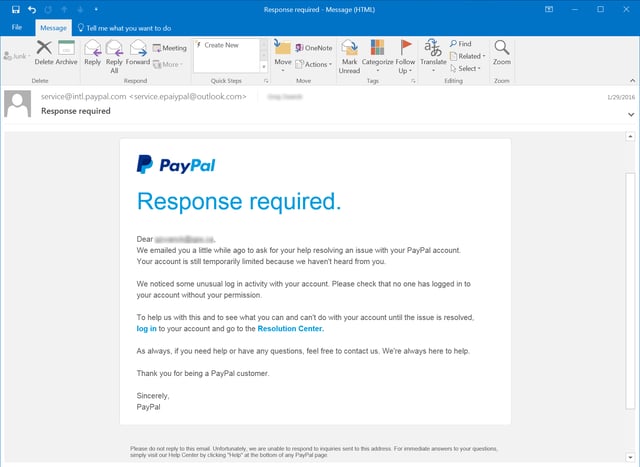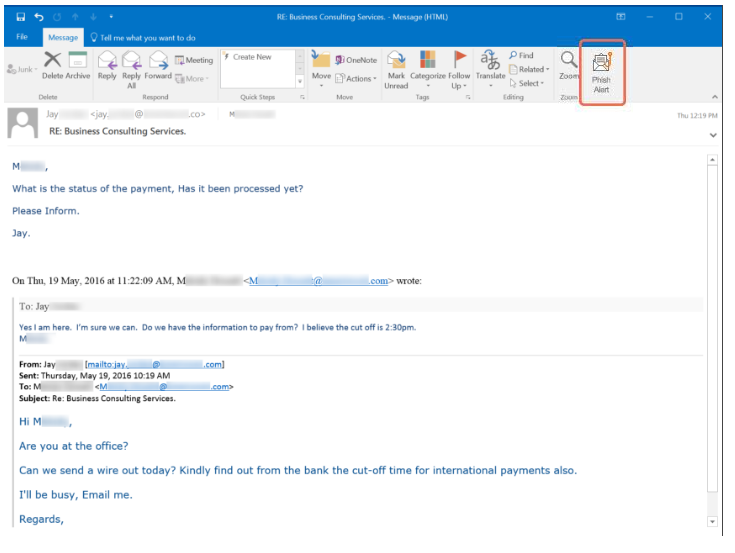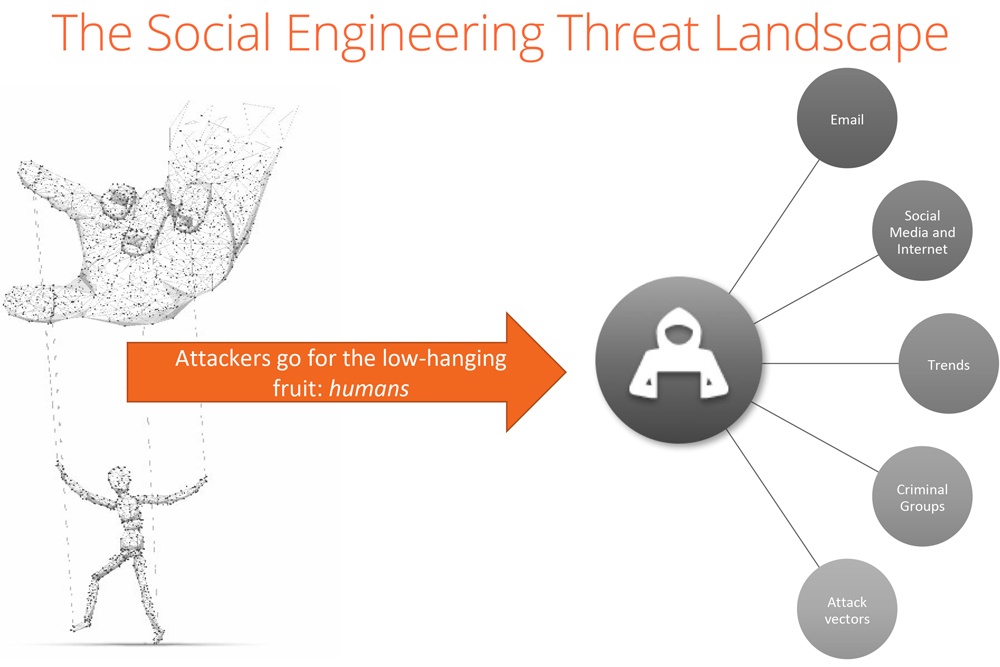What is social engineering?
Social Engineering is the art of manipulating, influencing, or deceiving you in order to gain control over your computer system. The hacker might use the phone, email, snail mail or direct contact to gain illegal access. Phishing, spear phishing, and CEO Fraud are all examples.
How dangerous is it?
“…Many of the most damaging security penetrations are, and will continue to be, due to Social Engineering, not electronic hacking or cracking… Social Engineering is the single greatest security risk in the decade ahead.” — Gartner, 2010"
Social Engineer
OK, so who are these people? It could be a hacker in the USA who is out to do damage or disrupt. It could be a member of an Eastern Europe cybercrime mafia that is trying to penetrate your network and steal cash from your online bank account. Or, it could be a Chinese hacker that is trying to get in your organization’s network for corporate espionage.
Top 10 Techniques Used By Social Engineers
Understanding the different attack vectors for this type of crime is key when it comes to prevention. This is how the bad guys do it:
| Pretexting An invented scenario is used to engage a potential victim to try and increase the chance that the victim will bite. It's a false motive usually involving some real knowledge of the victim (e.g. date of birth, Social Security number, etc.) in an attempt to get even more information. |
Diversion Theft A 'con' exercised by professional thieves, usually targeted at a transport or courier company. The objective is to trick the company into making the delivery somewhere other than the intended location. |
| Phishing The process of attempting to acquire sensitive information such as usernames, passwords, and credit card details by masquerading as a trustworthy entity using bulk email which tries to evade spam filters. Emails claiming to be from popular social web sites, banks, auction sites, or IT administrators are commonly used to lure the unsuspecting public. It’s a form of criminally fraudulent social engineering. Also, see Spear Phishing. |
Spear Phishing A small, focused, targeted attack via email on a particular person or organization with the goal to penetrate their defenses. The spear phishing attack is done after research on the target and has a specific personalized component designed to make the target do something against their own interest. Here is more about how they do it. |
| Water-Holing This technique takes advantage of websites people regularly visit and trust. The attacker will gather information about a targeted group of individuals to find out what those websites are, then test those websites for vulnerabilities. Over time, one or more members of the targeted group will get infected and the attacker can gain access to the secure system. |
Baiting Baiting means dangling something in front of a victim so that they take action. It can be through a peer-to-peer or social networking site in the form of a (porn) movie download or it can be a USB drive labeled “Q1 Layoff Plan” left out in a public place for the victim to find. Once the device is used or malicious file is downloaded, the victim’s computer is infected allowing the criminal to take over the network. |
| Quid Pro Quo Latin for 'something for something', in this case, it's a benefit to the victim in exchange for information. A good example is hackers pretending to be IT support. They will call everyone they can find at a company to say they have a quick fix and "you just need to disable your AV". Anyone that falls for it gets malware like ransomware installed on their machine. |
Tailgating A method used by social engineers to gain access to a building or other protected area. A tailgater waits for an authorized user to open and pass through a secure entry and then follows right behind. |
| Honeytrap A trick that makes men interact with a fictitious attractive female online. From old spy tactics where a real female was used |
Rogue Also, Rogue Scanner, rogue anti-spyware, rogue anti-malware or scareware, rogue security software is a form of computer malware that deceives or misleads users into paying for the fake or simulated removal of malware. Rogue security software, in recent years, has become a growing and serious security threat in desktop computing. It is a very popular and there are literally dozens of these programs. |
Scary New Threats in 2024
- The exponential growth of the ransomware plague. This attack isn't going anywhere. We'll see a rise in attacks that exfiltrate data, giving the bad guys a secondary way to get ransom payments with threats of data exposure. Also, ransomware-as-a-service strains will grow, allowing newbies to easily get in on the game. Kits sell for anywhere from $10 to a few thousand dollars. Custom-made ransomware attacks focusing on high-value targets (ie healthcare organizations) has been on the rise, that trend will continue. Also, POS systems being shut down is in the near future.
- Pseudo-ransomware will continue to be used to distract organizations. They seem like ransomware on the surface, but really in the background hackers are just trying to infiltrate the organization. Multi-vector attacks including smishing, phishing and vishing will increase.
- Phishing automation - bots and intelligent scraping of social media and dark web will make automated spear phishing a very hard to identify the problem. The amount of data stolen in breaches over the last couple of years makes it very easy to automate mass spear phishing attacks.
- Extortion scams with a long tail for businesses and individuals. Rather than immediate payment to get files back, a different tactic being used is demand sensitive content (such as ransomware that demands nudes, or in the corporate world demanding customer info to get data back). Expect micro-ransomware; extortion one document at a time.
- Search result tampering that will drive users to compromised websites are nothing new, but we will see an increase in this technique this year.
- Mobile malware - new families are on the way that will target smartphones and mobile-first users
- Blame-ware and False-Flag operations will increase - The European Union recently declared cyber attacks as acts of war and will appropriately respond to countries carrying out such attacks. Expect to see cyber propaganda operations that are engineered to spark controversy between countries, undermine democracies and destabilize trust globally. Watch out for related clickbait!
Phishing
A classic example is the tech support scam, and it comes in many varieties and levels of sophistication.
Over the past few years, online service providers have been proactively messaging customers when they detect unusual activity on their users' accounts. Not surprisingly, the bad guys have used this trend to their advantage. Many of the emails are designed poorly with bad grammar, etc. but others look legitimate enough for someone to click if they weren't paying close attention.
Consider this fake Paypal security notice warning potential marks of "unusual login activity" on their accounts:

Hovering over the links would be a dead giveaway that this is a phishing email, but enough targeted users click without thinking and scams like this continue.
Spear Phishing
In a spear phishing attack, threat actors use a deep knowledge of the potential victims to target them, and that approach allows them to tailor the attack. These emails are more convincing and harder to detect than regular phishing emails. The attacker knows exactly who and what they're targeting.
Unlike mass phishing emails which may be attempting to distribute ransomware or gather individual login credentials to make a quick buck, spear phishers are normally after confidential information, business secrets, etc.
CEO Fraud
Here's an example of a CEO fraud attempt targeted at a BizCare client. She received an email from an individual purporting to be the president of the company. The employee initially responded, then remembered her training and reported the email via our Phish Alert Button, alerting her IT department to the fraud attempt.
When the employee failed to proceed with the wire transfer, she got another email from the bad guys, who probably thought they had her fooled:

Because this employee had gone through proper security awareness training, she was able to keep her company out of the headlines. This was a close call though, and not everyone is that lucky!
Social Media
Cybercriminals create bogus profiles on social media and try to trick you. They will impersonate a celebrity or one of your friends or colleagues. These profiles look very much like the real thing, and it’s easy to get tricked. They try to impersonate a celebrity that the bad guys already know you like a lot.
Let’s say you were tricked into believing a bogus Social Network profile. The next step is that they try to make you click on a link or install malicious software, often something to watch a video or review photos. If you click or do that install, it’s highly likely you will infect your desktop with malware that allows the attacker to take over your PC.
Attacks
You may have heard of Norton antivirus, published by Symantec. The technical director of Symantec Security Response said that bad guys are generally not trying to exploit technical vulnerabilities in Windows. They are going after you instead. “You don’t need as many technical skills to find one person who might be willing, in a moment of weakness, to open up an attachment that contains malicious content.” Only about 3% of the malware they run into tries to exploit a technical flaw. The other 97% is trying to trick a user through some type of social engineering scheme. This means it does not matter if your workstation is a PC or a Mac. The last line of defense is… you guessed it: YOU!

| Social Media and Internet | Trends | Criminal Groups | Attack Vectors | |
|
|
|
|
|
How to prevent attacks?
10 Ways To Make Your business community a Hard Target
- With any ransomware infection, nuke the infected machine from orbit and re-image from bare metal
- Get Secure Email Gateway and Web Gateways that cover URL filtering and make sure they are tuned correctly
- Make sure your endpoints are patched religiously, OS and 3rd Party Apps. Test the Flexera Personal Software Inspector on your workstation
- Make sure your endpoints and web gateway have next-gen, frequently updated (a few hours or shorter) security layers, but don’t rely on them
- Identify users that handle sensitive information and enforce two-factor authentication for them
- Review your internal security policies and procedures, specifically related to financial transactions to prevent CEO fraud
- Check your firewall configuration and make sure no criminal network traffic is allowed out to C&C servers
- Leverage new-school security awareness training, which includes frequent social engineering tests using multiple channels, not just email
- You need to have weapons-grade backups in place
- Work on your security budget to show it is increasingly based on measurable risk reduction, and try to eliminate overspending on point-solutions targeted at one threat-or-another
Phone: 925-293-2222
Email: [email protected]
Client Portal: www.support.bizcare.com
Website: www.bizcare.com/contact-us
